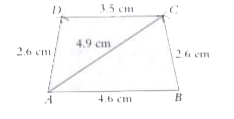Which of the following steps is INCORRECT while constructing a quadrilateral KITE, given that Kl = 9 cm, IT = 6 cm, KE = 5 cm, diagonal KT = 14 cm and diagonal IE = 6 cm ?
Step 1. Draw KI = 9 cm.
Step 2. With Kand I as centres and 5 cm and 6 cm as radii respectively, draw arcs to cut each other at E.
Step 3. Join KE and IT. With K and I as centres and 14 cm and 6 cm as radii, respectively, draw arcs to cut each other at T.
Step 4. Join KT and IE. Join TE also. KlTE is the required quadrilateral.
Only step 1
Both step 2 and step 3
Only step 3
Both step 3 and step 4
The correct Answer is:D
To determine which step is incorrect in constructing the quadrilateral kite KITE, let's analyze each step systematically.
Step 1: Draw KI = 9 cm.
- This step is correct as it establishes one side of the kite.
Step 2: With K and I as centers and 5 cm and 6 cm as radii respectively, draw arcs to cut each other at E.
- This step is also correct. We are using the lengths KE = 5 cm and IE = 6 cm to find point E.
Step 3: Join KE and IT. With K and I as centers and 14 cm and 6 cm as radii, respectively, draw arcs to cut each other at T.
- Here, we notice an issue. The instruction to "join KE and IT" is misleading because point T has not been defined yet. The point T should be constructed by drawing arcs from K and I, but the mention of IT is premature as we have not yet established where T is located.
Step 4: Join KT and IE. Join TE also. KITE is the required quadrilateral.
- This step is also incorrect because it refers to joining KT before T has been properly defined in the previous step.
Conclusion:
The incorrect steps are primarily in Step 3 where the mention of joining IT is out of context, as point T has not yet been established. Therefore, the error lies in the construction process, particularly in how the points are referenced before they are defined.
- This step is correct as it establishes one side of the kite.
- This step is also correct. We are using the lengths KE = 5 cm and IE = 6 cm to find point E.
- Here, we notice an issue. The instruction to "join KE and IT" is misleading because point T has not been defined yet. The point T should be constructed by drawing arcs from K and I, but the mention of IT is premature as we have not yet established where T is located.
- This step is also incorrect because it refers to joining KT before T has been properly defined in the previous step.
The incorrect steps are primarily in Step 3 where the mention of joining IT is out of context, as point T has not yet been established. Therefore, the error lies in the construction process, particularly in how the points are referenced before they are defined.
Topper's Solved these Questions
- BOOK - SCIENCE OLYMPIAD FOUNDATION CHAPTER - IMO MODEL TEST PAPER 2EXERCISE - EVERYDAY MATHEMATICS10videos
IMO MODEL TEST PAPER 2
- BOOK - SCIENCE OLYMPIAD FOUNDATION CHAPTER - IMO MODEL TEST PAPER 1EXERCISE - ACHIEVERS SECTION5videos
IMO MODEL TEST PAPER 1
- BOOK - SCIENCE OLYMPIAD FOUNDATION CHAPTER - IMO QUESTION PAPER 2017-18 SET AEXERCISE - ACHIEVERS SECTION5videos
IMO QUESTION PAPER 2017-18 SET A
Similar Questions
Construct a quadrilateral ABCD, give that AB=5cm, BC=7cm, AD=4cm, diagonal AC=9 cm and diagonal BD=6cm.
View SolutionConstruct a quadrilateral ABCD give that AB=4 cm, BC=3cm, AD=3.5cm, diagonal AC=5 cm and diagonal BD=6cm.
View SolutionConstruct a quadrilateral ABCD given that AB=5cm, BC=4cm, CD=4.5cm, DA=3cm and diagonal AC=4cm.
View SolutionConstruct a quadrilateral ABCD in which AB = 4 . 6 cm, BC = 2.6 cm, CD = 3.5 cm AD = 2 . 6 cm, and the diagonal AC = 4 . 9 cm
 View Solution
View SolutionIs it possible to construct a quadrilateral ABCD in which AB = 3 cm, BC = 4 cm, CD = 5.4 cm, DA = 5.9 cm and diagonal AC = 8 cm? If not, why?
View SolutionConstruct a quadrilateral ABCD in which AB=4cm, BC=3.4cm, AD=2.8cm, diagonal AC=4.6cm and diagonal BD=4.2cm.
View SolutionConstruct a quadrilateral BEAR in which BE = 6 cm, EA = 7 cm, RB = RE = 5 cm and BA = 9 cm. Measure its fourth side.
View SolutionConstruct a quadrilateral PQRS with PQ=3cm, QR=3.8 cm, RS=4.1 cm, PS=3.4 cm and diagonal PR=5 cm.
View SolutionConstruct a quadrilateral ABCD in which AB =4.6 cm , BC=2.6 cm, CD=3.5 cm, AD=2.6 cm , and the diagonal AC=4.9 cm.
 View Solution
View SolutionConstruct as quadrilateral ABCD in which AB=4.8cm, BC=4.3cm, CD=3.6cm, AD=4.2cm and diagonal AC=6cm.
View Solution

